Review of Captain’s Log, a solo-journaling Star Trek TTRPG
As a longtime Trekkie, I was VERY excited to check out Captain’s Log, a solo-journaling Star Trek TTRPG! Whether you are already a Trek fan or new to the universe of content, this wonderful guide to the creation of Star Trek stories sets you up for creating a meaningful adventure of your own.
*This post may contain affiliate links. At no additional cost to you, I may earn a small commission from purchases made using them. TTRPGkids uses this to keep the site going. Read full disclosure here.
Jump to:
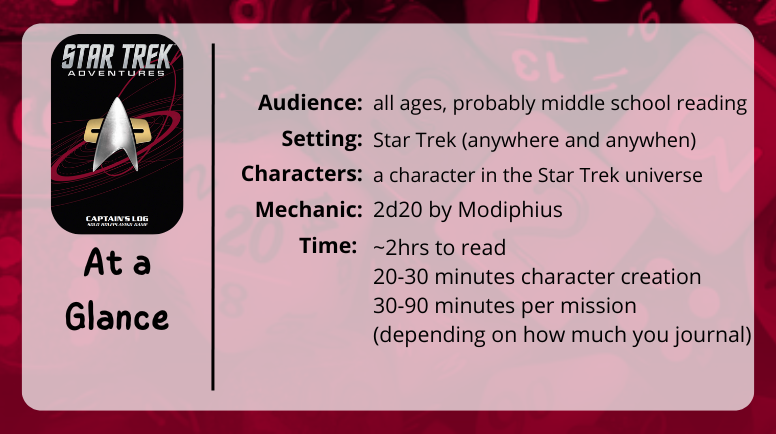
Audience for Captain’s Log
Captain’s Log is made for both fans of Star Trek AND folks who are new to the stories, providing lore and technical details that can either be a fun deep dive or a solid way to get up to speed on the people, tech, politics, and more discussed throughout the book.
Content is going to be directed by you, the player, in what types of missions you choose and how you let them develop throughout your telling of the story. Star Trek itself varies greatly on its content (compare Trouble With Tribbles and Darmok to Chain of Command Part II and Shuttle to Kenfori), so you have freedom to use what kind of content you wish.
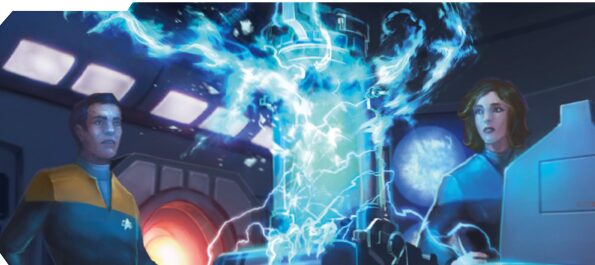
The general mechanics are pretty easy to understand once you have read the book; there’s a small amount of math, adding two stats and comparing d20 rolls, but other than that, it is journaling based. That said, the book does contain quite some explanation, so it is probably going to be about a middle school and higher reading level OR players could get some help with rules explanation/summarization from someone who has read the book already (i.e. I read the book in full and then explain to 7yo kiddo).
Setting for Captain’s Log
Captain’s Log is set in the wide time and space of the Star Trek universe. You can play from the early years of the Federation (like the Enterprise series) all the way out to the Federation’s future (like the Discovery series). You can play on a spacestation, patrol ship, research vessel, and more with missions that can include everything from space fights to diplomacy, research to slice of life.

And this book helps you to make a story that really FEELS like it’s from Star Trek.
A majority of the book’s content is on Trek lore, how episodes are structured (and how to translate that into your journaling), plot point suggestions, and critical themes that make these stories what they are.
There’s a focus on character stories, hopefulness (even if it’s a glimmer in an otherwise dark time), acceptance, curiosity, exploration, and inclusion. There’s a whole section on the Vulcan ethos (as stated by Spock): Infinite diversity in infinite combinations, meaning that we grow and discover and evolve by bringing unlike things together. The whole point is to find connection in what might not seem to be linked and to see where that leads.
Captain’s Log is very much a guide for how to take all the feelings that come with experiencing an episode of Star Trek and put it into a structure, not to control or limit it, but to give the player the chance to develop their own journey without losing those core feelings.
Characters in Captain’s Log

Captain’s Log is going to revolve around your particular character (or characters, if you’re doing multiplayer mode), and this tracks with what Trek is. Every story is about a character’s development and how their core values align or conflict with the mission.
Your character can be from Starfleet or a civilian, they can be from a planet or a ship, they may have an interest in art or cybernetics…. You get to pick!
The character creation section has a great walkthrough of how to choose your character without getting lost in all the options, how to establish a clear backstory with just a few prompts, and how to give them values that impact their choices later. This section will also assign your character stats (which will be discussed in the Mechanics section) as you make career, education, etc choices that give you different bonuses.
You’ll also get to create your ship (or station)! You’ll name your ship, choose its special features and stats, and be ready to head out.
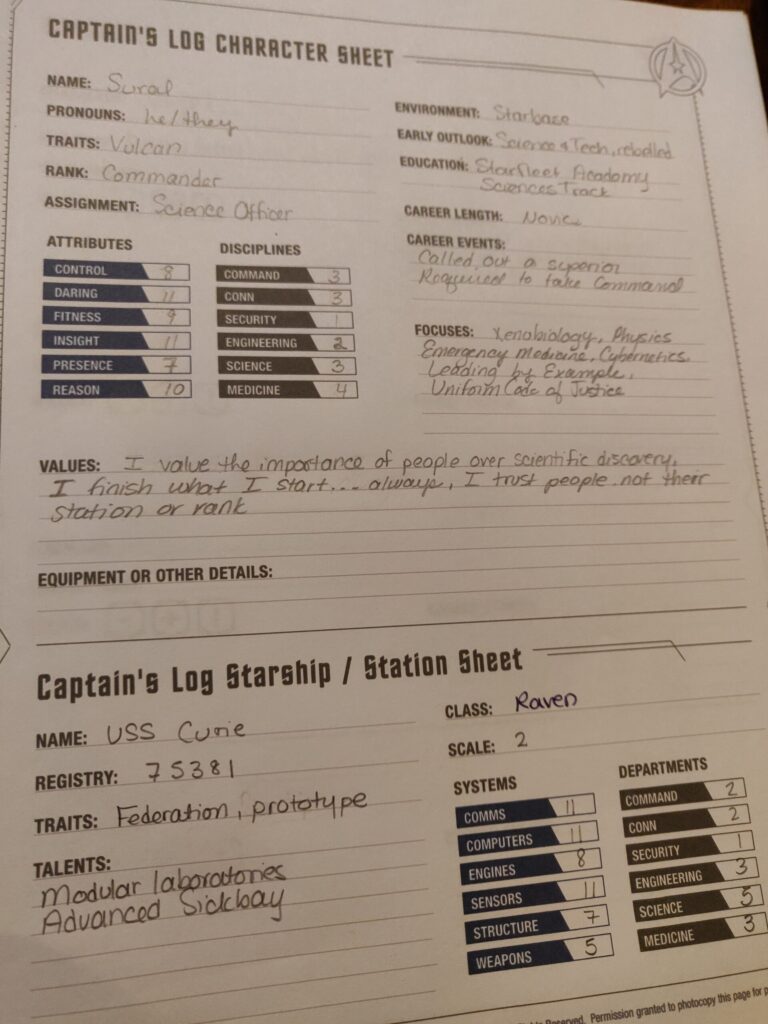
For my character, I made a rebellious Vulcan (because I wanted a little drama) named Sural who grew up on a Federation starbase (facilitating that rebelliousness a bit) and trained in xenobiology. He ended up being both insightful and daring, having previously taken command from a superior that was compromised during a prior mission, and he now leads a prototype Raven class research vessel, the USS Curie.
For his values, Sural values people over science, trusts people, not their rank, and finishes what he starts…. ALWAYS. He’s a bit adamant about that last point, which isn’t always a good thing.
It was VERY fun getting to pick all of Sural’s life choices and set him up for being an action-focused leader who would probably be running into a lot of away missions to new planets (these are some of my favorite episodes).
Mechanics for Captain’s Log
Captain’s Log uses Modiphius’s 2d20 system. You’ll essentially combine two stats to create a target number, then roll 2d20’s and compare to that target number. Each d20 that you roll equal to or below your target is a success. If you roll one success, you succeed! Two successes earns you a bonus (momentum), and no successes earns you a failure.
ALSO… nat 20’s are not good. Because you want to roll lower than your target, you want low rolls. A nat 20 represents the opposite of that, and you’ll get a threat. Which, when you roll 2d20’s, those can show up with some frequency.
Momentum lets you have some kind of boon, either for now or later (like negating a later threat), whereas a threat adds some kind of complication (like a visit from Q).

For your stats, you have two columns each for you and your ship that you’ll be using.
For your character, you’ll have your attributes (6 total), which are things like fitness, reason, and insight. You’ll also have your disciplines (6 total), which represent your experience with positions in security, engineering, and command. To create your target number, you pick one stat that makes sense from each list, and add the modifiers together.
For example, if I’m trying to solve a puzzle embedded within a computer terminal in ancient ruins, I might pick my reason (10) + engineering (2) = 12 to get my target number.
For your ship, you’ll have your systems (like comms and sensors) and your departments (like medicine and conn).
You’ll also be guided in your decisions by your character’s foci (like how mine studied xenobiology) and values. Values are statements that your character adheres to as part of who they are, and they are GREAT for creating new plot points.

This came up in a big way on my mission where Sural and a couple other officers were stranded on a destabilizing planet. They discovered that comms (and teleporter) were being jammed by an energy signal coming from an energy-based entity that was plugged into an ancient library as a power source (which is now abandoned). The entity was feeding on the planet’s core to survive, which was causing the destabilization and eventually would destroy all the knowledge in the ancient library. Stopping the entity or cutting it off from the core would allow us to beam out and save the library and planet, but it could kill the entity. This was something my character was NOT willing to do because of their values. So he found another way (shielding the chamber with the entity for a brief moment and beaming aboard before the planet blew)!
You’ll also track from mission to mission how your character grows, and this can change their values, letting you experience long character arcs that last through seasons of play. From that mission, my character may pick up a focus on energy-based lifeforms as they try to discover what the entity was, and the value of always finishing what they start may be challenged and adjusted as they fail to find the answers they seek over time and need to learn to let it go.
Overall thoughts on Captain’s Log
I LOVED this… and I also know I very much have a bias towards Trek. Before TTRPGs, Star Trek was “my thing”, and it has been a catalyst for several life decisions/events including my general interest in science and engineering and my first date with my partner (I asked him to go see the new Star Trek movie then answered all the trivia questions before the movie started… I am a proud nerd). So, as I’m playing this, I’m seeing reference to episodes that I love or watching the art progress chronologically from TOS to Lower Decks and beyond, in addition to being excited about the game.
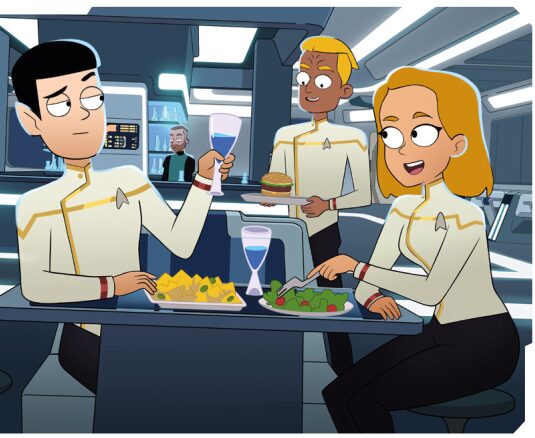
That disclaimer aside, this is a good solo-journaling game and a great guide for writing engaging stories. The core mechanics are easy to use and facilitate fluid gameplay. There’s also helpful diagrams to assist with navigating character creation, play sequences, and more. On top of that, the book walks you through how to create stories in general, what beats to hit, how to integrate theming, and what makes an engaging character.
Longtime Trekkies and new fans, journalers and first time storytellers, and everyone in between should be able to ENGAGE with Captain’s Log.
Find a Copy of Captain’s Log
You can find a copy of Captain’s Log on DTRPG!

If you liked this post, make sure to subscribe to the TTRPGkids monthly newsletter to stay up to date on the latest reviews, tips and tricks, game and podcast list updates, and more! Thank you for playing tabletop RPGs with your kids and sharing this awesome hobby with the next generation!
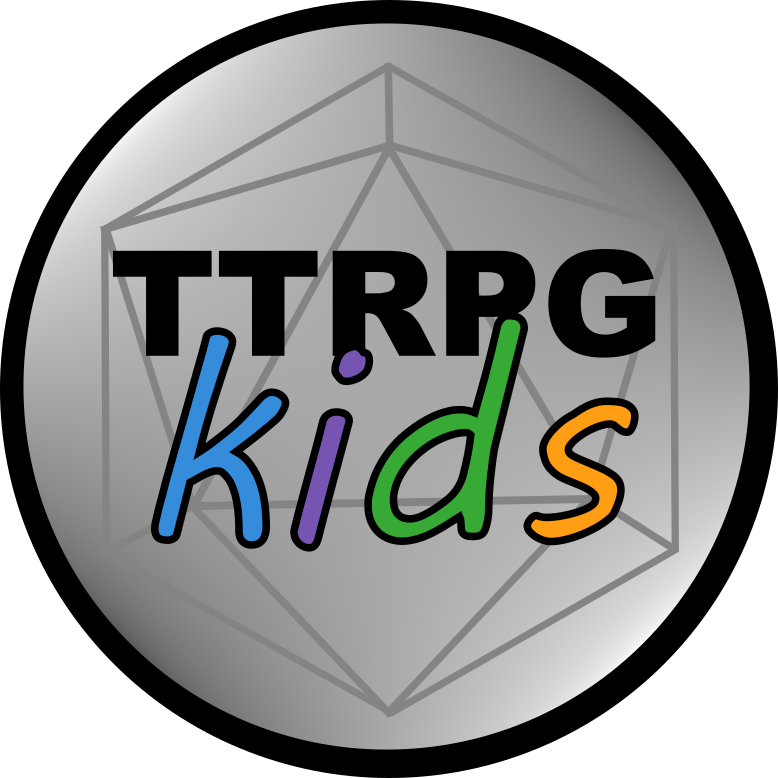

1 thought on “Review of Captain’s Log, a solo-journaling Star Trek TTRPG”